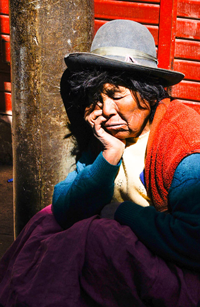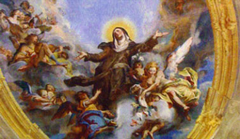St. Catherine of Bologna, Patron Saint of the Arts

Did you know...The intersection of faith and arts can lead to some surprising destinations. How about finding the trendy art vibe of Soho in a small parish center in New Jersey?St. Catherine of Bologna Arts Association of Ringwood, New Jersey holds an annual photo, art, and poetry exhibition called “A Little Bit of Soho in Ringwood.”The exhibition, held each year on the weekend nearest St. Catherine’s March 9th feast day, features hundreds of artists and draws thousands of visitors.
Jarius’ Daughter by John Dunic, winner of the Spiritual Award.  Peruvian Woman II, by Wanda Pawlowska, 1st place winner of People in Photography.
Peruvian Woman II, by Wanda Pawlowska, 1st place winner of People in Photography. |
A fifteenth-century cloistered nun who lived and died in relative obscurity doesn’t seem the most obvious choice to be Patron Saint of Artists. Yet a closer look at the life of St. Catherine of Bologna shows that she is indeed a saint worthy to intercede for and inspire artists. Her creative spirit, talents, visions, and struggle with doubts make her a saint even modern-day artists can relate to.
St. Catherine was born on Sept. 8, 1413, in Bologna, Italy to an aristocratic family. Her father, a diplomat to the Marquis of Ferrara, sent her to court when she was 11 to be a companion to the Marquis’ daughter, Princess Margarita. At the time, the city of Ferrara was becoming a cultural center, and so the young girls had an excellent education in music, literature, painting, and dancing. Catherine particularly excelled at miniature painting, Latin, and the viola.
When Margarita became engaged, she wanted Catherine to remain her companion, but Catherine felt called to the religious life. At 14, she became a Franciscan Tertiary, an order of lay women who followed the ways of St. Francis. A few years later, dissension in the community led Catherine and others to join the Poor Clares, a contemplative order founded by St. Francis and St. Clare of Assisi.

In spite of her aristocratic background and education, Catherine willingly served in the more humble roles at the convent, including laundress, baker, and caretaker to the animals. Late in her life, she obediently left her beloved Ferrara monastery to form a new convent in Bologna, where she served as abbess despite her desire for a less prominent role.
She continued in her artistic pursuits, playing the viola (even on her deathbed), painting religious pictures (her painting of St. Ursula hangs today in a gallery in Venice), copying out and illuminating her breviary (once belonging to Pius IX and now on display at Oxford), and writing spiritual guides and poetry.
Scholars and religious have shown a renewed interest in the guide she wrote for novices, The Seven Spiritual Weapons. One of the “weapons” she describes in that treatise might inspire Catholic artists today: in exhorting her sisters to trust in God, she tells them, “to believe that alone we will never be able to do something truly good.”
Throughout her life St. Catherine experienced mystical visions, which she documented in her treatise. She wrote that she had the ecstatic experience of having the baby Jesus placed in her arms by the Blessed Mother. She was also tormented by visions of the devil, but she was able to overcome these after many years of prayer.
At age 49, she became gravely ill and died a few months later. As was the custom of the Poor Clares, she was buried without a coffin. She was exhumed 18 days later after visitors noticed a sweet smell coming from her grave and some experienced miracles. Her body was found to be flexible and uncorrupted. Six hundred years later, her body remains intact. Her skin has blackened from exposure to oil lamps and soot, but still she sits, clothed in her nun’s robes, on a golden throne behind a glass case in the Church of the Saint in Bologna, resplendent in death as she would never have wanted to be in life.
She was canonized in 1712 and her feast day is March 9.
Pope Benedict XVI spoke eloquently of this humble saint:
“From the distance of so many centuries she is still very modern and speaks to our lives. She, like us, suffered temptations, she suffered the temptations of disbelief, of sensuality, of a difficult spiritual struggle. She felt forsaken by God, she found herself in the darkness of faith. Yet in all these situations she was always holding the Lord’s hand, she did not leave him, she did not abandon him. And walking hand in hand with the Lord, she walked on the right path and found the way of light.”
Photo courtesy of St. Catherine of Bologna Catholic Parish in Ringwood, NJ.

